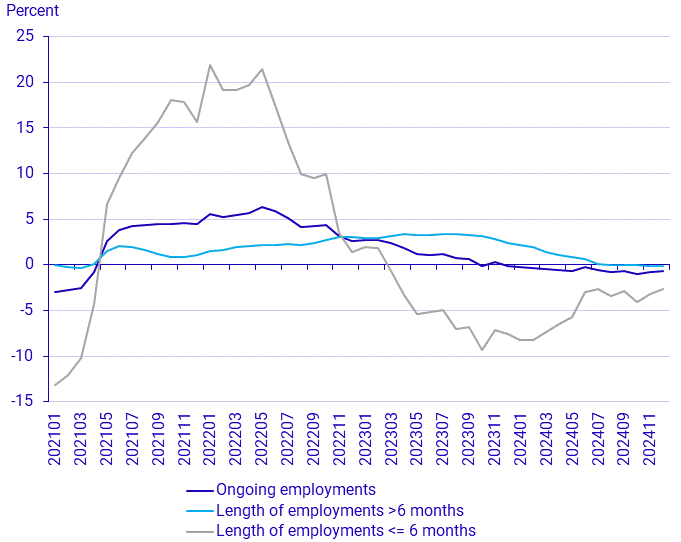Employment January 2025
From January 2025, Employments will be published monthly
Statistical news from Statistics Sweden 2025-03-31 8.00
The number of ongoing employments has continued to decrease. In January 2025, the decrease was 0.7 percent compared to the same month the previous year. During the same period, worked time decreased by 3.0 percent, amounting to 608 million hours. The proportion of sickness was 2.1 percent. The total gross pay was 191 000 millions SEK.
Aggregate gross pay, benefits, payroll taxes and preliminary tax statistics is now published
The former survey Aggregate gross pay, payroll taxes and preliminary tax statistics from employers monthly tax returns is now a part of the survey Employments. Data is disseminated from the reference period January 2020 and is now expanded to include monthly data, as well as data at regional levels.
In total for January 2025, the gross pay was 191 000 millions SEK, benefits was 3 000 millions SEK, payroll taxes was 60 000 millions SEK and preliminary tax was 51 000 millions SEK.
Ongoing employments continues to decrease
The number of ongoing employments decreased in January 2025 by 0.7 percent compared to the same period the previous year, amounting to 5 278 000.
Distributed by gender, 2 584 000 of the employments were held by women and 2 694 000 by men.
The number of employments lasting more than six month was 4 190 000 and the number of employments lasting six month or less was 1 088 000.

Worked time
The total number of hours worked in amounted to 608 million, which is a decrease of 3.0 percent compared to the same period the previous year.
| January 2025 | Annual change compared to the same period the previous year (%) |
|
|---|---|---|
| Ongoing employments | 5 278 000 | ‑0.7 |
| Women | 2 584 000 | ‑0.5 |
| Men | 2 694 000 | ‑0.9 |
| Length of employments >6 months |
4 190 000 | 0.0 |
| Women | 2 026 000 | 0.6 |
| Men | 2 164 000 | ‑0.6 |
| Length of employments <=6 months> |
1 088 000 | ‑3.2 |
| Women | 558 000 | ‑4.5 |
| Men | 530 000 | ‑1.8 |
| January 2025 | Annual change compared to the same period the previous year (%) |
|
|---|---|---|
| Started employments | 175 000 | ‑4.4 |
| Women | 84 000 | ‑6.4 |
| Men | 91 000 | ‑2.5 |
| Terminated employments | 405 000 | ‑2.0 |
| Women | 194 000 | ‑2.4 |
| Men | 211 000 | ‑1.6 |
| Worked time | 608 000 | ‑3.0 |
| Business sector | 407 000 | ‑3.8 |
| General government sector | 188 000 | ‑1.4 |
[1]Flow in employments are reported according to the flows of new employments, resumed employments, interrupted employments and re-interrupted employment. [2]Worked time is reported as the number of hours in thousands.
| January 2025 | Annual change compared to the same period the previous year[3] |
|||||
|---|---|---|---|---|---|---|
| Proportion of sickness absence |
Number of compensation days per employment |
Number of ongoing sickperiods per employmnet |
Proportion of sickness absence |
Number of compensation days per employment |
Number of ongoing sickperiods per employmnet |
|
| Total | 2.1 | 0.48 | 0.16 | ‑0.2 | ‑8.0 | ‑6.9 |
| Women | 2.5 | 0.55 | 0.18 | 0.0 | ‑1.3 | ‑0.8 |
| Men | 1.8 | 0.40 | 0.13 | ‑0.3 | ‑14.9 | ‑13.2 |
| Buisness sector | 1.9 | 0.42 | 0.14 | ‑0.2 | ‑10.1 | ‑8.9 |
| Central government | 1.7 | 0.37 | 0.11 | ‑0.1 | ‑6.4 | ‑5.9 |
| Regions | 2.6 | 0.58 | 0.21 | ‑0.3 | ‑9.2 | ‑6.3 |
| Municipalities | 3.2 | 0.71 | 0.23 | ‑0.1 | ‑4.2 | ‑3.5 |
| Non-profit institutions serving households |
1.5 | 0.34 | 0.10 | 0.1 | 6.9 | 2.1 |
[3] Change in the proportion of sickness absence is reported in percentage points, while Change in the number of compensation days per employment and Change in the Number of ongoing sickperiods per employment are reported in percent.
Definitions and explanations
Employments (ANST) consists of two parts. One part is register-based and is based on employer declarations at the individual level (PAYE) collected by the Swedish Tax Agency. The second part consists of the Sickness Absence during the Sick Pay Period (SuS), a sample survey where Statistics Sweden collects the data from employers.
The purpose of the register-based part is to depict the state of the labour market and its development over time. The statistics are used, among other things, for economic forecasts and are part of the European Union's labour market statistics.
The variable worked time is not entirely register-based; instead, it is derived from a model.
The purpose of SuS is to highlight sickness absence during the sick pay period, which is the first 14 days of sickness absence funded by the employer. The statistics are used for forecasts, analyses, and decision-making.
Feel free to use the facts from this statistical news but remember to state Source: Statistics Sweden.
